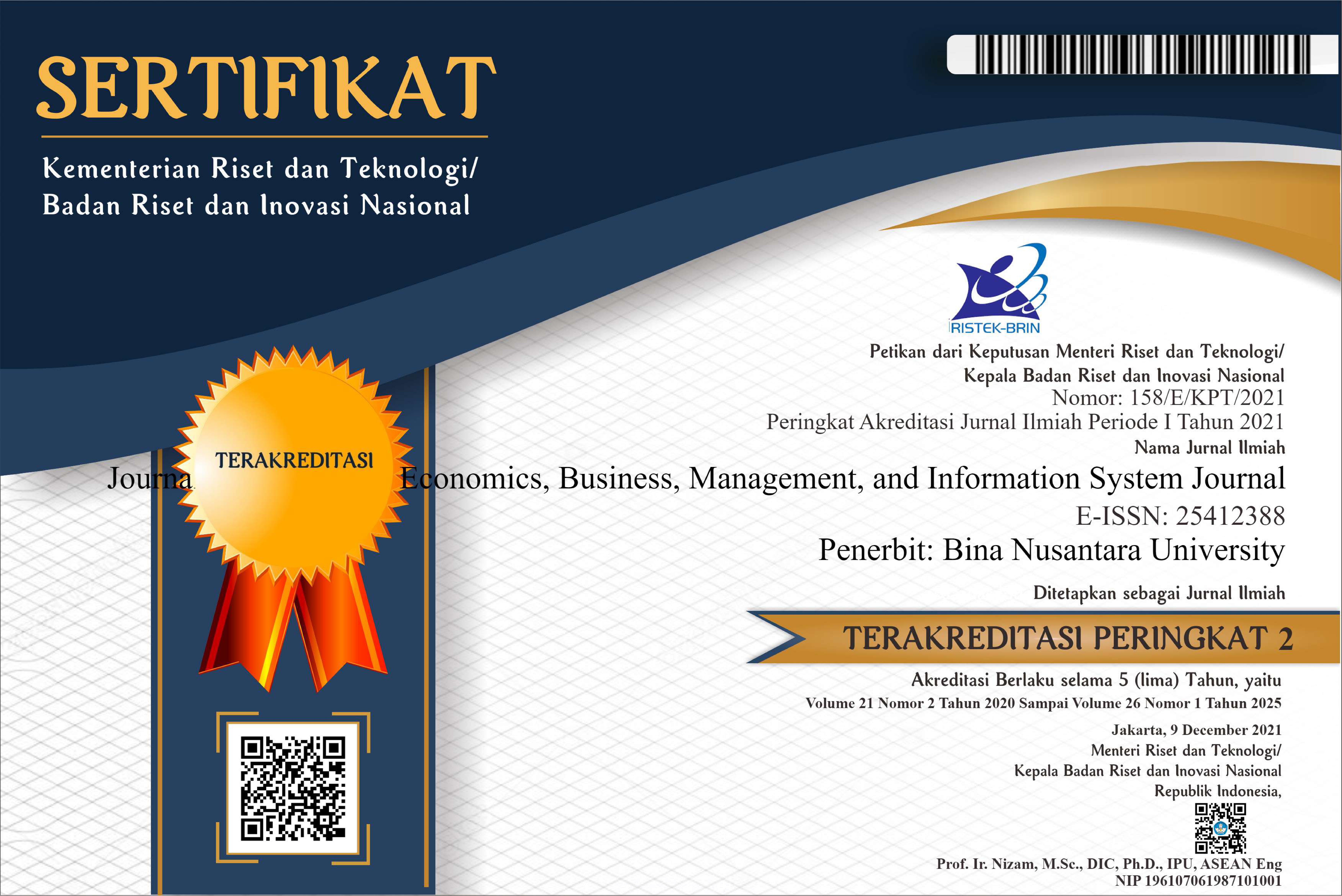Creativity-Relevant Personal Characteristics among Indonesia Creative Workers
DOI:
https://doi.org/10.21512/tw.v15i2.627Keywords:
creative behavior, creative-relevant personal characteristics, factor analysis, the big five factor personalityAbstract
The study aims to identify Creativity-relevant Personal Characteristics among creative workers in Indonesia’s creative industry. Identification of the constituent elements of the nature of the changes needs to be measured. Researchers have advocated replacing creativity-relevant personal characteristics based on the five-factor model to investigate how individual differences stimulate creativity. This study presents data supporting reliability (internal consistency) and validity (criterion and construct) of the instrument. Validity of the instrument is based on the content validity involving art and design experts. The 220 creative workers from several creative industry firms in Indonesia participated as samples in this research. Results of a factor analysis indicated a five factor solution of creative characteristics and behavior. Discussion of findings and the most important ways in which individuals differ in their enduring emotional, interpersonal, experiential, attitudinal, and motivational styles for stimulating creativity are presented.
Plum Analytics
References
Amabile, T. M. (1983). The social psychology of creativity: A componential conceptualization. Journal of Personality and Social Psychology, 45, 357–376.
Amabile, T. M., & Gryskiewicz, S. S. (1988). Creative human resource in the R&D laboratory: how environment and personality affect innovation. In R. L. Kuhn (Ed.), Handbook of Creative and Innovative Managers. New York: McGraw Hill.
Clapham, M. M. (1997). Ideational skills training: A key element in creativity training programs. Creativity Research Journal, 10, 33–44.
Costa, P.T. Jr., & McCrae, R. R. (1992). Revised NEO Personality Inventory (NEO-PI-R) and NEO Five-Factor Inventory (NEO-FFI) Manual. Odessa, FL: Psychological Assessment Resources.
Cronbach, L. J. (1951). Coefficient alpha and the internal structure of tests. Psychometrika, 16, 297–334.
Domino, G. (1974). Assessment of cinematographic creativity. J. Pers. Soc. Psychol, 30, 150–154.
Gough, H. G. (1979). A creative personality scale for the Adjective Check List. Journal of Personality and Social Psychology, 37, 1398–1405.
Hair, J. F., Black, W. C., Babin, B. J., Anderson, R. E., & Tatham, R. L. (2006). Multivariate Data Analysis (6th ed.). New Jersey: Pearson Education.
Harrington, D. M. (1975). Effects of explicit instructions to “be creative” on the psychological meaning of divergent thinking test scores. J. Pers, 43, 434–54.
Hoban, M. (2002). An Exploration of Creative Traits and Behaviors. Retrieved May 3rd, 2012 from http://serendip.brynmawr.edu/bb/neuro/neuro02/web3/m1hoban.html.
Horng, J., & Lin, L. (2009). The development of a scale for evaluating creative culinary products. Creativity Research Journal, 21(1), 54–63.
Kim, J. O., & Mueller, C. W. (1978). Factor Analysis: Statistical Methods and Practical Issues. Beverly Hills, California: Sage.
Kirton, M. J. (1976). Adaptors and innovators: a description and measure. J. Appl. Psychol, 61, 622–629.
Kirton, M. J., & De Ciantis, S. M. (1987). Management style and thinking style. In W. J. Reddin (Ed.), Effective Management. McGraw-Hill.
Levitt, T. (2002). Creativity is not enough. Harvard Business Review, 80(8), 137.
Mumford, M. D., & Gustafson, S. B. (1988). Creativity syndrome: Integration, application, and innovation. Psychological Bulletin, 103, pp. 27–43.
Munroe, A. S. (1995). Is your design a life sentence? Machine Design, pp. 156.
Oldham, G. R., & Cummings, A. (1996). Employee creativity: personal and contextual factors at work. Academy of Management Journal, 39, 607-634.
Pervin, L., & John, O. (Eds.). (1999). Handbook of Personality: Theory and research. New York: Gilford.
Rogers, E. M. (1983). Diffusion of Innovations. New York: The Free Press, a Division of MacMillan.
Schuler, R., & Jackson, S. (1987). Linking competitive strategies and human resource management practices. Academy of Management Executive, 1(3), 207–219.
Scott, S. G., & Bruce, R. A. (1994). Determinants of innovative behavior: a path model of individual innovation in the workplace. Academy of Management Journal, 37, 580–607.
Setiadi, N. J. (2009). Identifikasi Unsur-unsur Pembentuk Sifat Perubahan (Change DNA) dalam pembentukan Cara dan Pola Pikir Mahasiswa FBM Universitas Widyatama. Working paper report. BPPM-Universitas Widyatama. Unpublished.
Setiadi, N. J., Boediprasetya, A., & Wahdiaman. (2012). Boosting Indonesia’s creative industries: Identification of people’s characteristics and creative behaviour. J. Quaestiones Geographicae, 31(4), 53–62.
Setiadi, N. J., Boediprasetya, A., & Wahdiaman. (2011). Seberapa kreatifkah pekerja Anda? Panduan mengukur potensi dan kinerja kreatif seseorang (How creative your employees? A Guide to measure someone's creative potential and performance). Jakarta: Prenada Media.
Thakray, J. (1995). That vital spark (creativity enhancement in business). Management Today, pp. 56–58.
Tierney, P., Farmer, S. M., & Graen, G. B. (1999). An examination of leadership and employee creativity: the relevance of traits and relationship. Personnel Psychology, 52, 591–620.
Wahdiaman. (2009). Ungkapan visual rangkaian tumbuh dalam wujud medium seni rupa berbasis ruang dan waktu. Working paper report. BPPM-Universitas Widyatama. unpublished.
Woodman, R. W., Sawyer, J. E., & Griffin, R. W. (1993). Toward a theory of organizational creativity. Academy of Management Journal, 18, 293-321.
Downloads
Published
Issue
Section
License
Authors who publish with this journal agree to the following terms:
a. Authors retain copyright and grant the journal right of first publication with the work simultaneously licensed under a Creative Commons Attribution License - Share Alike that allows others to share the work with an acknowledgment of the work's authorship and initial publication in this journal.
b. Authors are able to enter into separate, additional contractual arrangements for the non-exclusive distribution of the journal's published version of the work (e.g., post it to an institutional repository or publish it in a book), with an acknowledgment of its initial publication in this journal.
c. Authors are permitted and encouraged to post their work online (e.g., in institutional repositories or on their website) prior to and during the submission process, as it can lead to productive exchanges, as well as earlier and greater citation of published work.
USER RIGHTS
All articles published Open Access will be immediately and permanently free for everyone to read and download. We are continuously working with our author communities to select the best choice of license options, currently being defined for this journal as follows: Creative Commons Attribution-Share Alike (CC BY-SA)

















